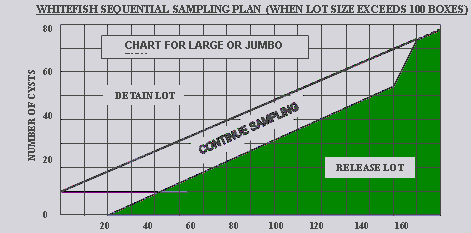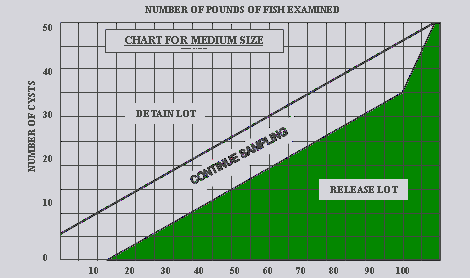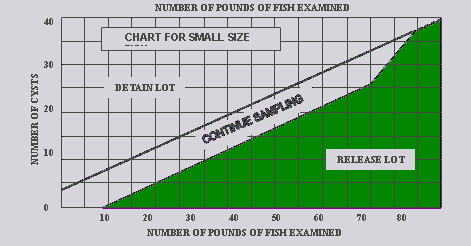|
| |
Sample Schedule 5 - IMPORTED WHITEFISH SAMPLING SCHEDULE
GENERAL This Sample Schedule objective is to maintain import lot integrity from time of importation thru FDA inspection or examination and final action. Shipments will be special manifested from non-lab ports to DO cities and other cities designated by the DD as FDA inspection points. These shipments will arrive in Customs bonded trucks under seal applied by Customs at the port of entry. Customs Entry documents and commercial invoice will accompany each shipment. The commercial invoice contains a description of the lots in the shipment and will serve as a guide in the selection of the lots to be sampled. - Special Manifested Shipments:
- Determine if seals are intact and record seal number.
- FDA metal seals may be broken and lots checked against invoice.
- Customs seals may be broken only if authorized by Customs.
- Lots which are not to be examined will be released by completing the "MAY PROCEED" block of the FDA-701.
- Sample lots to be examined by using either the Single or Sequential Sampling Plan depending on whether examination is made at the DO Lab or at the dock. The Sequential Plan can only be used where additional fish are immediately available for cutting.
- Definition of a Lot & Selection for Examination.
- A lot is defined as "Each group of fish of a distinct size, listed in the invoice as from a distinct lake, will be considered as a separate lot. Where an invoice does not list lakes of origin of boxes of fish in a shipment, fish of the same size and kind will be considered to comprise a single lot. When the size of the fish or lakes of origin in a shipment are not specified, the shipment will be treated as a single lot."
- Limit sampling to lots containing 5 or more boxes unless deliberate splitting up of lots is suspected.
- Basis for Sampling. Select lots for sampling on either a "selective" or "objective" (random) basis. The criteria in selective sampling may be prior knowledge or suspicion that fish listed as from a given lake are likely to have excess cysts; that the shipper has been known to manipulate shipments; etc. Regardless of the reason for selective sampling, record the basis for sampling each lot in your examination report. Simply list the basis as "selective" or "objective" next to the results of each lot sampled.
- Normally, select boxes in a lot for sampling at random. However, where there's evidence of layering, selectively sample the suspect boxes.
- Sampling Schedule.
- Imported samples of whitefish & related fish for parasites. The sampling schedules estimate lot quality more precisely, thereby reducing the likelihood of passing a lot which should be detained, or vice versa, due to an inadequate sample.
SCHEDULE A below is a single sample plan for use in collecting samples for examination in the district lab or other location where it is impossible or undesirable to return and obtain additional fish. SCHEDULE B below contains sequential sampling plans for use when the exam is made at a customs office or a carrier's dock where you have immediate access to the lot and can obtain additional fish, if necessary. The sequential plan for lots of 20 to 100 boxes is presented in tabular form. the sequential sample plan for lots of 100 or more boxes is presented in a sampling chart. For small lots of 5-20 boxes, a sequential sample plan is not feasible. All import sampling plans are based on lot size and the sizes of the fish in the lot. When lots are very good or very poor quality, in terms of cyst infestation, double sample plans require a smaller sample size on the average than single sampling plans, to reach a decision. b. Domestic Samples for Parasites. - For Laboratory Examination. Lots of 11 or more boxes; Collect at least 25 fish from a representative number of boxes. For small lots, under 11 boxes; Collect 12 fish from a representative number of boxes.
- For Examination in Other Than Laboratory. Cut a preliminary sample in accordance with the appropriate double sampling plan, Schedule B. Cut the additional sample where indicated or bring the additional sample to the laboratory for examination.
SCHEDULE A - SINGLE SAMPLE PLAN | Number of Boxes in Lots | NUMBER OF KG'S (POUNDS) IN A SAMPLE 1/ | | | Jumbo or Large 2/ | Medium 2/ | Small 2/ | | 5 - 19 boxes 20 - 100 boxes 100 or over | 12.7 Kg (28lbs) 24 Kg (73lbs) 32 Kg (70lbs) | 10.5 Kg (23lbs) 20.5 Kg (45lbs) 25.5 Kg (56lbs) | 7.3 Kg (16lbs) 15 Kg (33lbs) 17.8 Kg (39lbs) | 1/ When an invoice does not designate the size of the fish in the shipment and inspection reveals more than one size in the lot, use sampling plan for medium fish. 2/ RANGE OF WEIGHT OF FISH IN EACH SIZE CLASS: SMALL Under 675 gms (1 1/2lbs)
MEDIUM 675 gms (1 1/2lbs) & under 1.4 Kg (3lbs)
LARGE 1.4 Kg (3lbs) & under 1.8 Kg (4lbs)
JUMBO Over 1.8 Kg (4lbs) | SCHEDULE B - SEQUENTIAL SAMPLE PLAN 1. Limited to lots of 20 - 100 boxes. 454 Kg (1000lbs) to 2272 Kg (5000lbs) | | Size of Fish 1/ | Size of preliminary Sample | Cysts/45.5 Kg (100lbs) in Preliminary Sample | Size of ADD'L SMPL | Cysts/45.5 Kg (100lbs) in sample | | | | PASS | DETAIN | TAKE ADD'L SMPL | | PASS | DETAIN | | Large & Jumbo Medium Small | 16 Kg (35lbs) 12.3 Kg (27lbs) 8.2 Kg (18lbs) | 30 or less 26 or less 38 or less | 70 or more 67 or more 61 or more | 31-69 27-66 39-61 | 28.6Kg (63lbs) 19.5 Kg (43lbs) 11.8Kg (26lbs) | 49 or less 49 or less 49 or less | 50 or more 50 or more 50 or more | | 1/ When an invoice does not designate the size of the fish in the shipment and inspection reveals more than one size in the lot, use sampling plan for medium fish. 2/ For lots of 100 boxes or over, use the Sequential Sampling Chart for the particular size fish in the lot. | 


|


